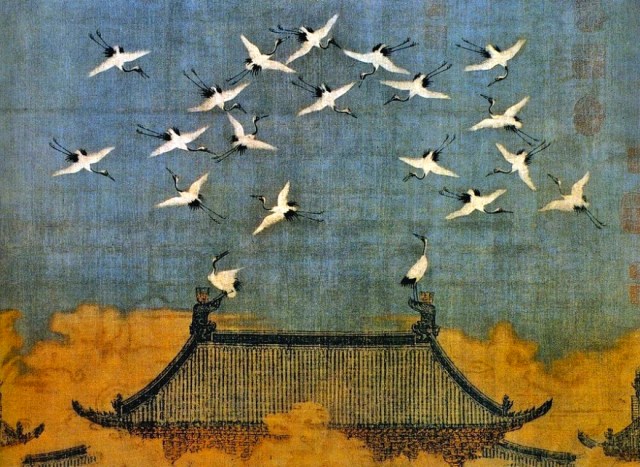Along the River During the Qingming Festival (清明上河图) is one of the most acclaimed classic Chinese masterpieces created by Zhang Zeduan (张择端, 108-1145). It is a 5-metre long painting that illustrates a panoramic street scene of the Chinese capital Bianliang (汴梁) in the 11th century, located in today’s Kaifeng, Henan.

This section of the painting shows restaurant staff loading cooked food onto a cart for takeaway orders.
According to historical records, China developed an advanced fast food and takeaway culture more than a thousand years ago. (“逐时施行索唤” “咄嗟可办”), and instead of doing home cooking, middle-class families preferred to dine out or order takeaways. (“市井经纪之家,往往只于市店旋买饮食,不置家蔬”)

Chinese characters displayed on a panel next to a store read “香软子“, meaning fragrant and soft, which is an ancient Chinese summer drink.
Soft drinks were quite popular among Chinese people during the Song Dynasty.

A teahouse was fully open to the street.
Ancient Chinese loved tea and teahouses were everywhere.

The pole with a figure of a bird at the top is a kind of radar used to detect the wind direction (depending on the orientation of the bird’s head).

Stalls were selling fresh bouquets of flowers in the morning market.
Historical records show practicing floral art was part of people’s daily life in the Chinese capital of the Song Dynasty. During the spring seasons, the sound of vendors peddling flowers in a melodic way could be heard everywhere (“是月季春,万花烂漫,牡丹芍药,棠棣香木,种种上市,卖花者以马头竹篮铺开,歌叫之声,清奇可听”).
Daily lives in China nearly a thousand years ago, with boats in the river, houses by the water, trading activities along the streets and the night markets at every corner …
Animated classic Chinese ink painting Riverside Scene at Tomb Sweeping Festival by contemporary Chinese artists.

Cranes in the Royal Palace – a colour painting by the last North Song emperor Huizong (1080-1135). Song Huizong was one of the finest painters in Chinese history & the creator of Slim Gold style calligraphy. During his lifetime, he completed more than 600 paintings, most are works of birds and flowers.
COMMENTS FROM GOOGLE PLUS
Aug 2016
Plautus Satire
More fragile yet astonishingly well-preserved artifacts from the “song dynasty” after fifty years of Mongol warfare and hundreds of years of yuan suppression and cultural imperialism. If only the sticky rice mortar recipe had survived so well!
All Things Chinese
Mongols never had cultural and/or technology suppression in China (which was what Manchu did), and Mongol’s rule only lasted for less than 100 years, not several centuries. Besides, China’s civilisation is so long, cultural heritages are so many, the population is so big and the territory is so broad, while Mongols were/are a small nation, they never had the intention nor ability to wipe out Chinese culture.
Nicole Wildman
By emperor. It’s amazing.
All Things Chinese
Most Chinese emperors were quite talented as they were coached by the best men in the subject field.
This particular emperor of Northern Song was especially a towering figure in China’s art history. He created a special writing style called “Slim Gold” that becomes the basis of today’s printing font.
However, he wasn’t a good emperor, because he had no interest in managing state affairs. Imagine a devoted artist becomes a politician…
Plautus Satire
He had lots of leisure time
All Things Chinese
Most Chinese emperors didn’t have much leisure time. They had to get up at dawn to host daily cabinet morning meetings, and they needed to review and approve piles of government papers each day.
Once the second Ming Emperor had flu and appeared a bit late at the cabinet meeting, for which he received a partition of criticism from a surveillance officer and he issued a decree of public apology.
Of course, there were lazy emperors too who ignored the criticism but kept pursuing their hobbies, such as painting, poetry, carpentry, Taoist cultivation, kung fu …
As for this particular Song emperor, he lived for his art at the cost of half of China’s territory.
By then China was the most wealthy nation in the world, and the emperor and his pleasure-seeking officials dreamed they could buy peace from ruthless and ambitious foreign antagonists.
As the result northern China was occupied by the early form of Manchus and the Chinese capital was forced to relocate from Bianliang (Kaifeng) in today’s Henan province to Hangzhou in Zhejiang along China’s east coastline.
As for himself and his son, they were captured by the Manchus and their bodies were fed to a furnace as fuel to light.

This is part of a modern tree stump art crafted by a group of China’s top stump folk artists with the theme based on the pairing “Along the River During the Qingming Festival”.